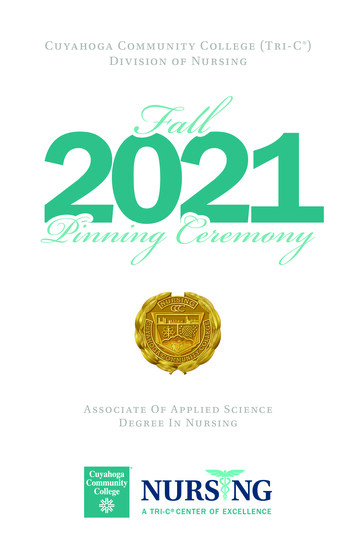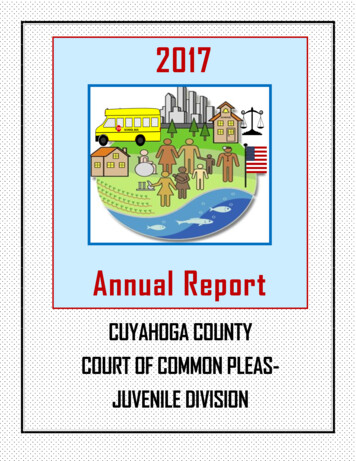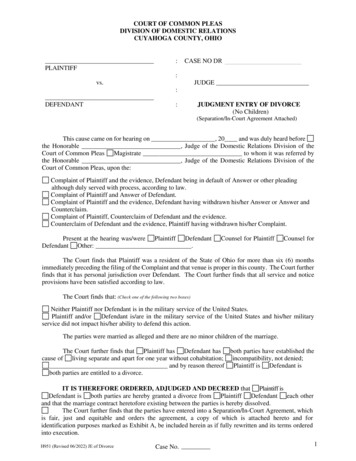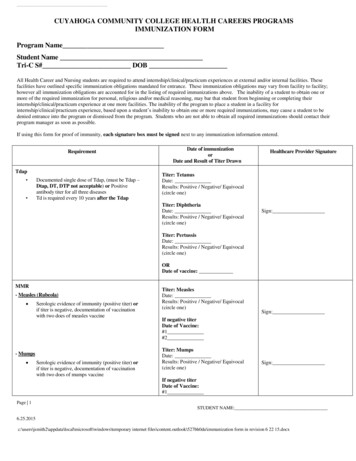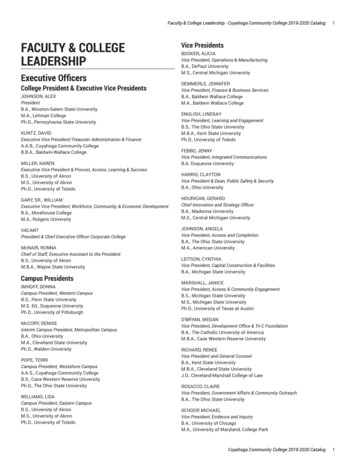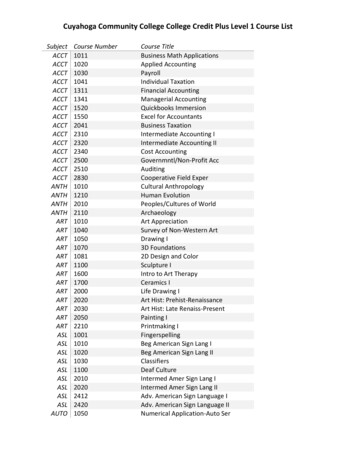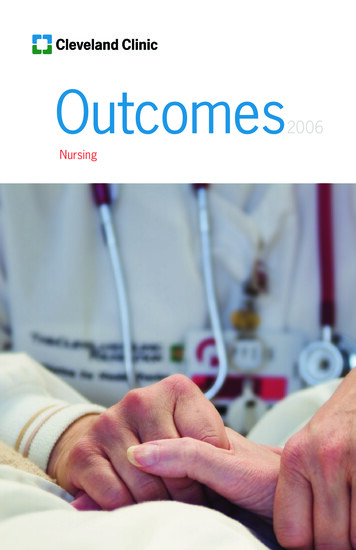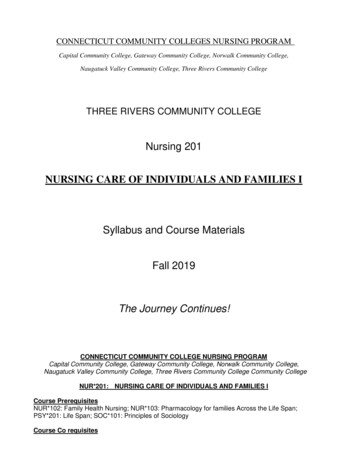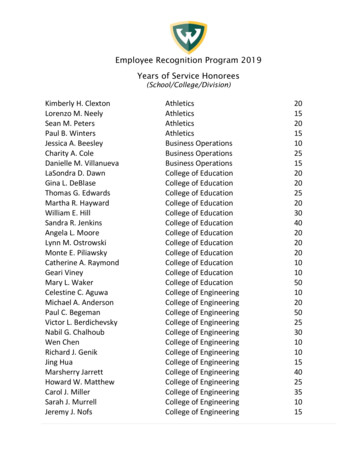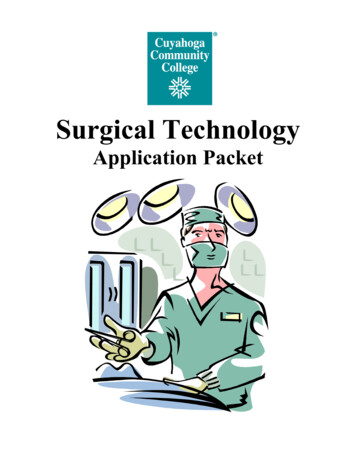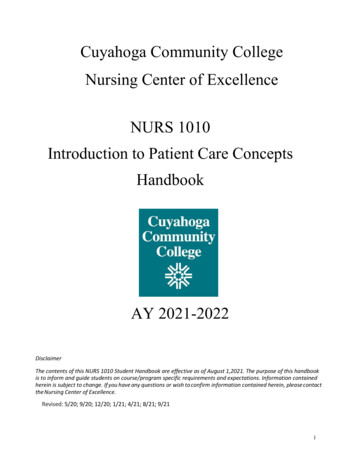
Transcription
Cuyahoga Community CollegeNursing Center of ExcellenceNURS 1010Introduction to Patient Care ConceptsHandbookAY 2021-2022DisclaimerThe contents of this NURS 1010 Student Handbook are effective as of August 1,2021. The purpose of this handbookis to inform and guide students on course/program specific requirements and expectations. Information containedherein is subject to change. If you have any questions or wish to confirm information contained herein, please contactthe Nursing Center of Excellence.Revised: 5/20; 9/20; 12/20; 1/21; 4/21; 8/21; 9/21i
Table of ContentsSection I – Welcome Letter . 1Section II – Program Description . 21. Mission, Vision and Philosophy .22. Core Values .23. Division of Nursing Education . 24. Course Description .25. Course Admission Requirements .3Section III – Course Expectations . 31. Professional Standards .32. Code of Ethics .43. Professional Attire Requirements (Lab & Clinical).44. Student Code of Conduct .55. Health and Physical Requirements.8Section IV – Academic Expectations, Requirements and Progression.101. Orientation .102. Registration/Scheduling.103. Lab .104. Clinical .115. Illness/Tardiness/Absences .136. Course Evaluation. 18Section V – Academic Status . 181. Grading .182. Course Withdrawal, Probation, Dismissal, and Reinstatement .193. Due Process .194. Student Change of Contact Information .21ii
Section VI – Language Proficiency Requirements . 22Section VII – Student Resources . 221. Tutoring .222. Student Accessibility Services .223. Student Safety .224. Other Resources .23Section VIII – Accreditation and Credentialing . 231. College and Academic Program Accreditation .23Section IX – Costs . 241. Tuition and Fees .242. License, Application, Certification and/or Examination costs.243. Financial Responsibility.25Section X – Field and Clinical Experiences . 271. Holidays .272. Emergency Closures and Inclement Weather .27APPENDICES . 28Appendix I – Glossary of College and Program Terminology .27Appendix II – Student Incident Reporting .30Appendix III – Handbook Acknowledgement Form .31iii
Section I – Welcome LetterDear Student:On behalf of the faculty and administration, we welcome you to the Nursing Center of Excellence at CuyahogaCommunity College. Upon successful completion of NURS 1010: Introduction to Patient CareConcepts, youwill meet the educational requirements to register for the Ohio Department of Health State Tested NursingAssistant Examination.This course is challenging and rewarding and requires significant outside time commitments to besuccessful. Weunderstand that many students must continue to work as they seek to advance themselves academically, but it iscritical that you take time to make the appropriate lifestyle adjustments prior to beginning this course and utilizethe numerous resources available here at the College to ensure your success.The faculty and administrative staff are eager to help you throughout the course. We have developed thisStudent Handbook to facilitate the successful completion of the course. The purpose of this handbook is toinform and guide students on specific requirements and expectations for NURS 1010: Introduction to PatientCare Concepts. The handbook includes a description of the course and policies and procedures specific to theNURS 1010 Introduction to Patient Care Concepts.You are encouraged to read the handbook and keep it for future reference. If you have questions regarding thecontent in the handbook, please feel free to clarify them with Primary Instructor (PI), Program Coordinator(PC), or the Nursing Center of Excellence administrative office.We wish you much success!Sincerely,Wendy Batch-Wilson, DNP, RNDean, Nursing Center of ExcellenceTalisha Cottingham, DNP, RNAssociate Dean, Nursing Center of ExcellenceJennifer Chaye MSN, RNDirector Nursing Skills Lab, Nursing Center of ExcellenceVada Mack, DNP, RN, EMBA, RN-BCProgram Director, Nursing Center of ExcellenceChristine Wyers, DNP, RNProgram Director, Nursing Center of ExcellenceSharon Wasko-Arnold, DNP, RNProgram Coordinator, Nursing Center of Excellence1
Section II – College/Division Overview1. Mission, Vision and PhilosophyThe College Mission:MissionTo provide high quality, accessible and affordable educational opportunities, and services — includinguniversity transfer, technical and lifelong learning programs —that promote individual development andimprove the overall quality of life in a multicultural community.VisionCuyahoga Community College will be recognized as an exemplary teaching and learning community that fostersservice and student success. The College will be a valued resource and leader in academic quality, culturalenrichment, and economic development characterized by continuous improvement, innovation, andcommunityresponsiveness.ValuesTo successfully fulfill the mission and vision, Cuyahoga Community College is consciously committed todiversity,integrity, academic excellence, and achievement of individual and institutional goals. We are dedicated tobuilding trust, respect, and confidence among our colleagues, students, and the community.2. Core Values3354:1-42-01 College Policy on affirmative action, inclusive excellence, equal opportunity, ence- 3. Nursing Center of ExcellenceThe Nursing Center of Excellence (COE) is an integral component of Cuyahoga Community College. Thephilosophy of the COE is consistent with the general mission of the College, which is to provide high quality,accessible, and affordable educational opportunities, and services to all members of the community.Theeducational environment of the College and the Nursing COE are designed to promote individual developmentand to improve the overall quality of life in a multicultural community.4. Course DescriptionNURS-1010: Introduction to Patient Care ConceptsIntroduces basic concepts necessary to care for patients within a variety of health care settings specificallyfocusing Long Term Care settings. Emphasis on developing observation and communicationskills, safety andemergency procedures, mobility/ergonomics, promoting and respecting patient rights, personal and restorativecare, basic nursing skills, mental health and social service needs, and infection2
control. Successful course completion qualifies student to register for state nurse aid exam and OhioDepartmentof Health STNA Certificate of Completion.Cuyahoga Community College Catalog: http://catalog.tri-c.edu/5. Pre-requisite Course AuthorizationIn order to be authorized for the NURS 1010 course, the applicant:1. Must have completed N1000: Introduction to Health Care Concepts with a grade of “C” or better.2. Complete the NURS 1010 interest survey. All students enrolled in NURS 1000 will receive an email from the Nursing Center of Excellenceto survey your interest in taking NURS 1010. Please click the link and complete the survey to beconsidered for entry into NURS 1010.3. Must have met the requirements for the Health Education Systems Inc Admission Assessment Exam-A2(HESI A2). Applicants must achieve a minimum score of 75% on the Math and English** sections forconsideration for the program. One attempt can be made per month. If a 2nd attempt is needed, only the section(s) scoring below 75% needs to be completed.**Three separate tests compose the English Language portion of the exam. The three tests are:Reading Comprehension, Vocabulary, and Grammar. Scoring less than 75% on the Englishcomponent requires completing all three tests again. There is a limit of 2 attempts in a 12-month period. Each attempt must be separated by 30calendar days. Applicants with an Associates Degree of higher, with a documented degree transcript on file withthe college registrar, are not required to take the HESI exam.4. Completed the health, CPR, and background check requirements. Beginning the background check is time sensitive. Completing this step too early can lead torepeating the background check at an additional cost.5. Submit ALL required documents within the established time frames of the semester to which you areseeking entry into NURS 1010. After reviewing all of the submitted documents as outlined above, the Nursing Center ofExcellence will reach out to all students eligible to take NURS 1010.6. For questions regarding preauthorization, please contact nursingprereqs@tri-c.edu.Section III – Course Expectations1. Professional StandardsStudent Responsibility StatementThe student is responsible for receiving this Handbook and adhering to the standards and procedurescontained herein. Any information contained herein is subject to modification, deletion, or change. Theprogram shall not implement changes to policies for student progression, or requirements for completion ofthe program, regarding students enrolled in the program at the time the changes are adopted. When there is achange in program or policy, the Handbook will be updated, and it will be communicated via the student’sTri-C email along with an announcement on the nursing group blackboard site.Students are also responsible for having their current address and telephone number reported to theEnrollment Center at any campus. This information can also be updated through My Tri-C space.3
Student Email Communications PolicyCuyahoga Community College (CCC) has established email as an official and primary means of communicationwith students. An official Cuyahoga Community email address is required for all students.The college expects that every student will receive email at his or her CCC email address and will read email ona frequent and consistent basis. A student's failure to receive and read college communications ina timelymanner does not absolve that student from knowing and complying with the content of such communications.Students may elect to redirect (auto-forward) email sent to their CCC email address. Students who redirectemail from their official CCC email address to another address do so at their own risk. If email is lost becauseof forwarding, it does not absolve the student from the responsibilities associated with communications sent totheir official CCC email address.2. Code of EthicsAcademic Honor CodeAny student found to have committed or to have attempted to commit any act of dishonesty, including cheating,plagiarism, or other forms of academic dishonesty, is subject to the disciplinary sanctions outlinedin the StudentJudicial System.Refer to the Student Conduct Code 3354:1-30-03.5 and Student Judicial System 3354:1-30-03.6 for moreinformation about violations and College disciplinary procedures. The Student Conduct and Academic Honorcode can be accessed via My Tri-C Space on the Student Services tab. The policies are located in theCollegeGuidelines channel located near the bottom of the page. Penalties for Academic Dishonesty are defined in the Student Judicial System 3354:1-30-03.6 - (D)Sanctions.Plagiarism as Academic Dishonesty is defined in Tri-C Student Handbook via My Tri-C Spaceonthe Student Services tab under College Guidelines.3. Professional Attire Requirements (Lab & Clinical)An official uniform is required for the clinical setting. Descriptions, model numbers, and supplier contactinformation for the student nurse uniform is located on the NURS 1010: Introduction to Patient Care Conceptsgroup site. Questions concerning the uniform may be directed to the Division of Nursing EducationOffice.Female (Dress or Pantsuit)*UniformMaternity SmockHoseSocksShoesIdentificationWhite Tunic Scrub TopWhite undershirtNavy Blue Scrub Pant WhiteScrub Dress SetWhite (3/4 length)WhiteWhite or Navy Blue only with pantsAll White (Closed toe and heel)Name BadgeThe uniform of the pregnant student will consist of a 3/4 length white smock.This will be worn over the pants or the skirt of the uniform during the clinical experience.4
Males*UniformSocksShoesIdentificationWhite Tunic Scrub TopWhite undershirtNavy Blue Scrub PantWhite or Navy BlueAll White (Closed toe and heel)Name Badge*Style numbers for scrubs can be found on the NURS 1010: Introduction to Patient Care Concepts group site.A complete uniform includes the following:1. A name badge above the left breast pocket provided by the Division of Nursing Education Office2. Watch with a second hand, and black and red ball point pens.3. The student is expected to present a professional appearance in the lab and clinical care setting:a. Uniform is to be worn to lab during all labs as well as during open lab times. Effective: first day ofclass. If someone has difficulty meeting this deadline, please alert your Primary Instructor.b. Shorts, cut-offs, exposed cleavage/midriff, clinging tops, tight pants, and short skirts maynot be wornto lab or clinical.c. No head gear (caps, decorative scarves, etc.) is acceptable in the lab orclinical, except headcoverings worn for religious reasons.d. All apparel should be wrinkle free and clean within the lab and clinical setting.e. Shoes worn in the lab should be clean, flat with closed heel and toes. Sandals will not be permittedin the lab.4. Additional Clinical Setting Guidelines:a. Dresses and skirts should be knee length. Pant hems should touch the top of the shoe.b. No sandals, opened toed or heel shoes, or clogs are permitted in the clinical area; shoesmust be clean,flat and white.c. Under garments must be worn. No visible colored underwear/garment lines, thongs, logos onunderwear will be accepted.d. Hair must be neat and of natural color. Clean, controlled, secured, and off the uniform collar. Nodecorative ornaments, headbands or hats are to be worn. Facial hair is acceptable if it is neat andtrimmed. Head coverings for religious purposes are allowed.e. False eyelashes are prohibited.f. A plain wedding band and one pair of small post earrings (one in each earlobe) are the onlyacceptablejewelry. No visible gauging or ear piercings. All other visible body piercings are not permitted.g. Tattoos must be covered.h. Gum chewing is not permitted.i.Sweaters are to be plain white or navy blue. Sweaters are not worn in patient care areas. Students maywear approved white jackets within the clinical setting.j.Fingernails should be clean and short (e.g. nails cannot be seen when looking at the palmof the hand.)Neither nail polish nor artificial nails are permitted.4. Student Code of ConductThe College acknowledges the importance of an environment that is conducive to learning. The StudentConduct Code and Judicial System serves to provide such an atmosphere that is conducive to educationgrowth and civility which fosters and protects the mission of the College. College Procedures on StudentConduct: Student Conduct Code and Student Judicial System , and Student Judicial System.5
Use of Cell Phones and Other Electronic DevicesAll cell phones must be turned off or placed on vibrate mode (silent) while students are in class. Similarly,otherelectronic devices – PDAs, pagers, instant message devices, games, other handheld devices, and laptopcomputers – should be silenced and stowed in a secure place during class.Primary Instructor (PI) may make exceptions to this policy in cases in which students are using electronic devicesfor academic purposes related to the class. For example, in many cases, Primary Instructor (PI) maypermit theuse of laptop computers if students are using the computers to take notes or for purposes related to the class.Students should check with their instructors about which devices are permissible in class. This includes use of allrecording devices.Primary Instructor (PI) have the right to instruct students to turn off laptops and other devices, and to stow thosedevices in secure places, in any class. Students who fail to follow the directions of a Primary Instructor (PI) inclass may incur disciplinary action up to and including suspension and dismissal from thecourse.Any student who uses electronic devices in any act of dishonesty will incur full disciplinary sanctions,according to the Cuyahoga Community College Student Handbook. This includes students who participateinthe improper sharing of information about tests via electronic devices, e.g., text messaging or posting onsocialmedia sites exam questions or answers, emailing information about exams, sending voicemail messages aboutexams or tests, or any similar use of technology to engage in academic dishonesty.Adapted from es-in-the-classroom/Social MediaSocial media are defined as, but not limited, to web-based or mobile technologies used for interactivecommunication. Examples of social media include but are not limited to collaborative projects (e.g., Wikipedia),blogs and microblogs (e.g., Twitter), content communities (e.g., YouTube), social networking sites (e.g.,Facebook, Snapchat, Instagram), virtual game worlds (e.g., World of Warcraft), and virtual social worlds (e.g.,Second Life). Regardless of how these forms of media are used students are responsiblefor the content they postor promote.Social media as a form of communication can be an effective way to promote nursing and improve thehealthand well-being of patients and their families. However, appropriate use of social media is essential toprotect the student, patients, Primary Instructor (PI), and the program.Anything posted to a social media site is potentially open to public viewing creating potentialunintended outcomes. Deleting content never removes the material from potential internet access.Additionally, inappropriate content may affect your professional reputation for years to come; as manyemployers and academic institutions routinely search potential candidate’s online reputations.Therefore, students must maintain strict adherence to standards of professionalism when posting tosocial media sites.Postings on social networking sites are subject to the same professional standards as any other personalinteractions. Students are prohibited from disclosing any of the following through social media:1. Protected Health Information, as defined by the Health Insurance Portability and AccountabilityAct(HIPAA). This includes posting information where patient identifiers have been removed.2. Confidential, non-public or proprietary information about patients and families, clinical facilitystaffor clinical institutions; of the School, its employees and students;3. Copyrighted or intellectual property*** belonging to the Primary Instructor (PI) or college.4. Comments that express or imply sponsorship or endorsement by the College, unless the individualis6
officially authorized to act in this capacity for this purpose on behalf of the College.5. Taking and displaying photos/videos of patients, or photos depicting the body parts of patients.Students in violation of this policy will be considered as having violated the Cuyahoga Community StudentConduct Code will be dismissed from the class and/or college.***NOTICE OF PRIMARY INSTRUCTOR (PI) COPYRIGHT AND INTELLECTUAL PROPERTYRIGHTS. Any intellectual property displayed or distributed to students during or after a course (includingbut not limited to Power points, notes, quizzes, examinations) by any professor(s) remainsthe intellectualproperty of the professor(s). This means that the student may not distribute, publish orprovide suchintellectual property to any other person or entity for any reason, commercial or otherwise, without theexpress written permission of the professor(s).VandalismAny destruction of property in the lab and/or clinical may result in permanent dismissal from the class.ChemicalSubstance AbuseIf at any time a Primary Instructor (PI) and/or clinical affiliate employee observes signs of the effects of mood-alteringdrugs in a student in the lab or clinical setting, a drug screen will be required of the student at that time and at thestudent’s expense. These signs may include, but are not limited to the following: altered judgment, impaired motorcoordination, inability to concentrate, memory loss, tremors, confusion, anxiety, delusions, agitation, disorientation,profuse diaphoresis, convulsions, slurred speech, emotional instability, delirium, hallucinations, depression,paranoia, hostility, hyperreflexia, and lethargy.Any violation of this policy will result in one or more of the following actions:1. Students will be required to sign a release of medical information form.2. Immediate blood alcohol level testing and/or urine drug screen testing.3. Suspension or administrative withdraw from the course.4. The student will be required to complete a chemical dependency evaluation at their own expense. Thetreatment and rehabilitation program as recommended by the agency must be followed as a condition forcontinuance in the course.5. The student will provide copies of the aftercare plans and the contracts to the Primary Coordinator (PC)and tothe Dean of Division of Nursing Education office (in writing) for acceptance or rejection of therecommendation.6. After the student has completed the treatment plan and met the terms of the contract, and therecommendation of the agency has been obtained, the student will be considered for return to full studentstatus. It should be noted that the student must follow the readmission policy of the Division of NursingEducation.7. Upon one repeat violation of this policy, the student will be permanently dismissed.8. Any refusal, on the part of the student, to participate in the recommended treatment and rehabilitationprogram will result in dismissal from the course.Criminal HistoryStudents who are charged or convicted of a crime of any type, other than a minor traffic violation, must report7
the offense to the applicable Program Coordinator/Associate Dean in writing within thirty (30) daysofconviction (conviction includes plea arrangements, guilty pleas, pleas of no contest, findings of guilt, etc.).For the most recent information regarding criminal history and working with patients in the long-term caresetting, please visit the link for Ohio Department of eaidetraininghowtoAny students found to violate professional and ethical standards may be referred to the College’s StudentCode ofConduct.5. Health and Physical RequirementsThe College establishes (use appropriate terms: health requirements, standards, and/or physical requirements)that meet the expectations of employers, field experience locations and/or clinical sites.Those requirementsinclude the following physical and cognitive qualifications:PerformanceStandardExamples of necessary activities(Not all inclusive)Physical strengthThe ability to assist in lifting ormoving patients of all age groupsand weights.Lift up to 35% of recommended body weightMobilityThe ability to move around thepatient’s room and in work areas.Stand and/or walk six to eight hours a dayWalk rapidly for a prolonged period fromone area to anotherBend or squat frequentlyProvide care for a patient in anelevatedhospital bed or stretcherPerform one man CPR whennecessaryAuditory acuityMotor SkillsAuditory acuity sufficient to hearinstructions, requests andmonitoring alarms.Gross and fine motor abilitiessufficient to provide safe and effectivenursing care.Hear sufficiently to detectchanges inpatient’s conditionHear sufficiently to interpretvariousequipment signalsAssist patient in performing ADL’s andusefacility equipmentCalibrate and use equipmentPosition and turn patients8
PerformanceStandardTactileTactile ability sufficient for physicalcontact.CommunicationExamples of necessary activities (Not allinclusive)Assist patient in performing ADLs.The ability to provide effectivewritten, oral and nonverbalcommunication with patients and theirfamilies, colleagues, healthcareproviders and the public.The ability to speak, write andComprehend the English languageproficiently.InterpersonalInterpersonal abilities sufficient tointeract with individuals, families andgroups from a variety of social,emotional, cultural and intellectualbackgrounds.Social behaviorCompassion, integrity, interpersonalskills, interest and motivation.ProfessionalismThe ability to adhere to ethicalstandards of conduct as well asapplicable state and federal laws.Stress managementEmotional maturity and stability toapproach highly stressful humansituations in a calm and rational manner.Explain procedures, document and interpretactions and patient responses.Give oral and written reports to othermembers of the healthcare teamEstablish rapport with patients and colleaguesDevelop a mature, sensitive and therapeuticrelationship with patients9
A qualified person with a disability who can perform these essential functions with any reasonable accommodationwill be considered for admission along with other qualified applicants. It will be the student’sresponsibility tocontact the Student Accessibility Services office for further information and assistance. es/index.htmlFor more information on health requirements for health programs, this link provides a guide and resources:HealthCareers and Nursing Immunization and Health Requirements.Section IV – Academic Expectations, Requirements and Progression1. OrientationPrior to beginning NURS 1010: Introduction of Patient Care Concepts, a mandatory orientation will be held toinform new students about the course and the support services available within the College. Students who do notattend this orientation will not be able participate in the course.2. Registration/ SchedulingInformation regarding registration, start/end dates for lab/clinical is posted on theNURS 1010: Introduction ofPatient Care Concepts group site. Once registration has closed and a clinical or lab placement has been assigned toa student, students are not permitted to change their selections. Request for clinical or lab placement changes afterthe registration process has closed, must be sent to the Program Coordinator. A written explanation for therequest and ALL supporting documentation of extenuating circumstances must accompany the request. If deemedappropriate, then the change will be granted on space available basis.***The sale, bartering of services or the offering of an incentive between students to change a clinical orlabplacement is prohibited. If a student(s) has been found to have done so, this will be considered a conductissue and will be subject to disciplinary action at the discretion of the Dean and/or Associate Dean of Divisionof Nursing Education.3. LabLaboratory Rules1. Students must sign in and out of the Lab.2. Equipment and supplies are to be cleaned, reassembled, and replaced in the designated area, by the student,foruse by the next person.3. Students are expected to always fol
Nursing Center of Excellence . NURS 1010 . Introduction to Patient Care Concepts Handbook . AY 2021-2022 . Disclaimer . The contents of this NURS 1010 Student Handbook are effective as of August 1,2021. The purpose of this handbook is to inform and guide students on course/program specific requirements and expectations. Information contained

